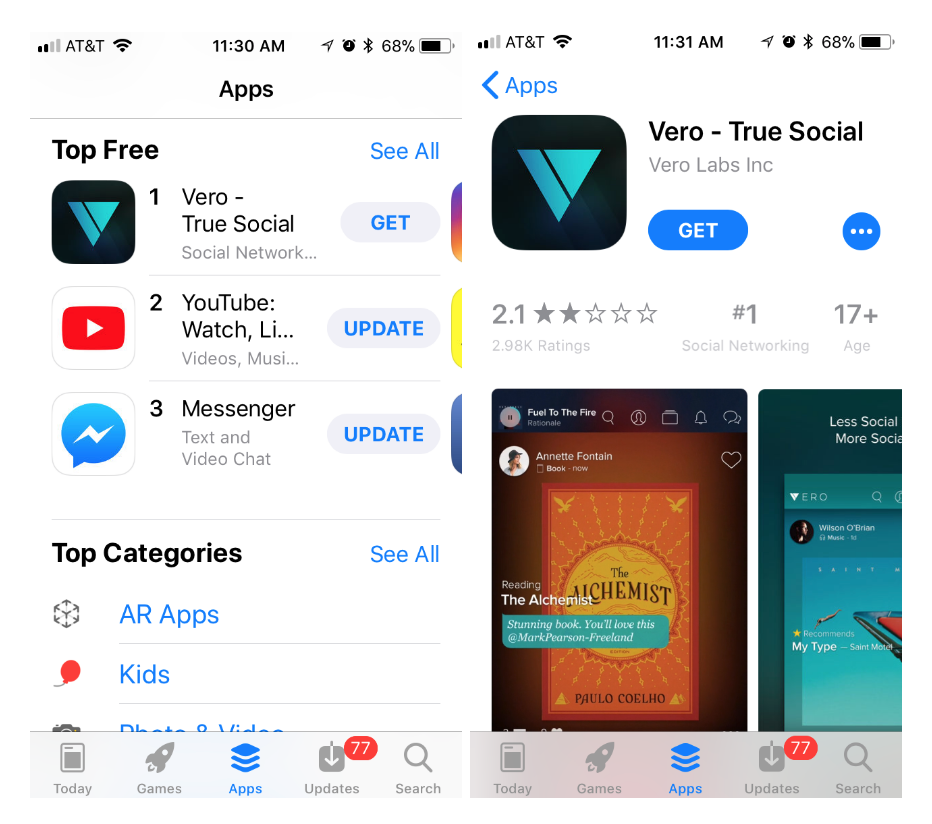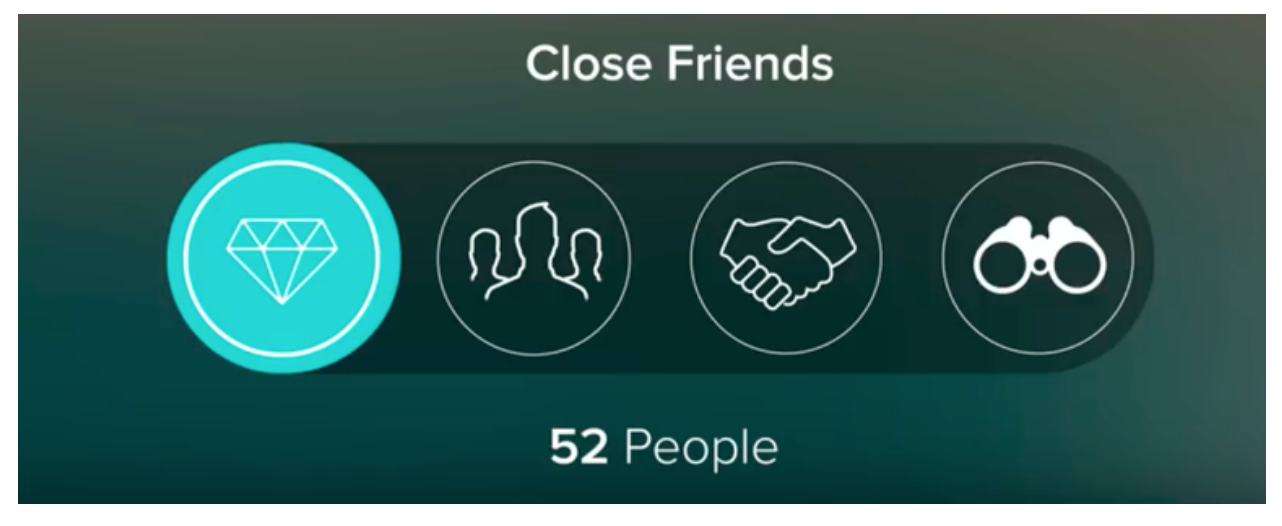What is Vero? Is This New Social Media App the Next Instagram?

Prior to this week you may have never heard of Vero, but the now-viral social media app seems to be everywhere–either being promoted on Instagram Stories by your favorite influencers or critiqued as an app disruptor by popular tech news sites. Interestingly enough, Vero is not a new platform, having actually launched back in 2015 by billionaire Ayman Hariri.
Developed out of a frustration with advertisements and a lack of authenticity found on Facebook and Twitter, Vero was meant to provide a more preferable social media solution that focuses on more genuine experiences, content sharing, and relationships. Why it’s just taking off now–and at such an exponential rate (it’s now the Top Free app in the App Store)–is uncertain, just as is the app’s fate as a contender against social media giants like Instagram.

What Makes Vero Different and How Does it Work?
How can one content-sharing social platform be that much different from what we already know, or so much better than our current go-tos that we might think of opening Vero before we open Facebook? Well, it might not be reinventing the wheel and it hasn’t won us over just yet, but there are some standout features that sets Vero apart from the rest.
No Advertisements or Algorithms
This is perhaps its biggest selling point right now, especially with all the ‘fake news’, Russian scandals, and algorithm changes that have plagued Facebook and Instagram. Vero’s founder felt that dominant social platforms were lambasting users with excessive, mistargeted ads, and providing a subpar experience by implementing algorithms that hindered how users saw content and interacted with their audience. The solution: ditching advertisements and algorithms in the development of Vero. No ads mean no data mining, which aligns with the strict privacy policies that the app prides itself on.
Newsfeed Is In Reverse Chronological Order
It seems like the entire internet has been complaining about their newsfeed since Instagram released its algorithm change, altering the order in which posts appear throughout our thumb scrolling. Memes and hashtags have surged in protest, but Instagram hasn’t caved, much to the chagrin of its users. That’s where Vero made a smart move, angling it as a more ‘authentic experience’, by offering a newsfeed that appears in reverse chronological order–oh, how we miss those days of old.
As a rep for the app explains, “The feed is composed of your posts and the posts of people you’re either connected with or people you follow. We don’t curate it, manipulate it, insert advertising in it, or hold back posts. You see what has been shared with you, when it’s been shared with you.” What a novel concept to actually be able see everything shared by your connections–in order. That in itself is almost worth giving Vero a try.
Categorized Followers to Filter Who Sees Posts (called an audience selector)
Now, this is definitely a feature unique to Vero. In apps like Snapchat and Instagram you can select individuals you don’t want seeing your content, and can also form groups to an extent, but Vero dials this down a little more. Based on the belief that social media should let you be yourself, and that you act differently in front of different groups, Vero wanted to offer the ability to filter the groups who see your content on social media; this way your messaging makes sense to that specific group. The app does this through its audience selector, which categorizes your followers into four groups: follower, acquaintance, friend, and close friend.

When you share something, you can select which level of friend you want to be able to see the post, which in theory will allow you to be yourself to a greater degree. Vero explains it as such: “When you can control who sees what, you can behave in a way that is more natural. We created a social network that lets you be yourself. Hence the name Vero. Meaning truth.” Beyond its audience selector, you can follow other users exactly the same as you do on other platforms, with friends, brands, and verified celebrities all having a presence on the app.
Multimedia Upload & Sharing Options
While many social platforms differentiate themselves by focusing on a singular category of content sharing (travel recs, beauty tips, shopping deals, movie suggestions, photography), Vero encourages and enables the capability to share a bit of everything. Not just limited to a simple text caption or a singular image, the app allows you to share photos, links, music, movies, television, books, and places.
In that sense, by merging the interests of a host of community platforms (think Instagram meets GoodReads meets G.Spotting meets Soundcloud meets Rotten Tomatoes meets Tumblr), it really opens up the opportunities to connect with your audience. And, with the audience selector feature, you can be even more certain that you tailor your content to the right group of friends. Vero makes it easy to search through its content with the ability to search posts from your contacts by medium/content type or by browsing popular hashtags.
Subscription-Based With an Annual Fee
While most of the social app giants offer their platforms for free, Vero intends to be a subscription-based app. However, it is this nominal fee that allows it to sustain its most defining feature: an ad-free platform. That being said, the app is currently being offered in mobile app stores for free, with a lifetime subscription available to the first 1 million users.
They have yet to confirm what the annual cost will be once they hit the one mill mark, but swirling rumors have suggested it won’t exceed $10. As far as a yearly expense goes, $10 is pretty doable (if that number is, in fact, accurate), but if you’re interested in trying out the app, now is the time while it’s costs nothing.
‘Buy Now’ Feature Allows In-app B2C Transactions
You must be wondering how this app plans to turn a profit as an ad-free platform with a low-entry price point. In addition to the pending annual subscription users will have to pay, Vero will also make money through the businesses that have profiles on the app. With it’s Buy Now feature, any brand that is offering or showcasing its product on Vero can sell to consumers without asking them to leave the platform; the customer can make the transaction directly through the app. In turn, Vero charges a transaction fee on any payment that it facilitates. The only question is whether the built-in cost is worth the convenience.
No Usernames or Avatars
Whereas Twitter, Snapchat, and Instagram lend some creativity to the profile setup by allowing you to create a username, Vero sticks to the basics. No username required, the signup simply asks for your name, email, and phone number. The app reasons that you don’t need all that user information when you aren’t selling data to advertisers or third parties. You can then search and add users by their contact information, and categorize them into labels (undisclosed to the contacts themselves), which are the same ones used in the audience selector.
Will Vero Replace the Social Media’s Top Dogs?
Never say never. On the one hand, it has seen insane growth almost overnight, which bodes positivity from a short-sighted perspective. Will it be able to sustain this growth, or will its momentum and novelty wane in favor of social giants like Facebook and Tumblr. The latter is not an uncommon fate met by apps recently found in similar scenarios. Just look at apps like Peach and Ello; both sought to offer something that Facebook was missing or doing incorrectly, both promised to be ad-free platforms, both sky-rocketed to the top of the app charts overnight, and both of died out just as fast.
We’re not saying that the same will happen to Vero–we’re willing to sit back and wait a few weeks before making any conclusions–but the app has definitely hit a few speed bumps on its quick ride to the top. With its sudden popularity, there has been a surge of technical issues for Vero–their server has been overloaded by the demand, impacting a user’s ability to share post or even create an account.
These IT issues have been followed by complaints about Vero’s tech support, perhaps contributing to its 2.1 out of 5-star rating on Apple’s App Store. These growing pains, compounded by a recent business scandal involving the app founder, have made for a rocky rise so far; what the future holds for Vero is unsure, but we can’t help but be extremely curious.
Our Editorial Standards
Reviewed for Accuracy
Every piece is fact-checked for precision.
Up-to-Date Research
We reflect the latest trends and insights.
Credible References
Backed by trusted industry sources.
Actionable & Insight-Driven
Strategic takeaways for real results.







